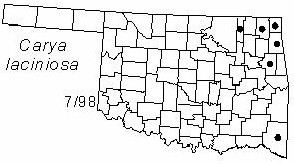Tree to 20 m (65 ft) tall and 50 cm (18 in) diameter, with narrow rounded crown. Bark light gray, becoming rough and shaggy (separating into long loosely attached strips) on older trunks and branches. Twigs thick, orange-brown, rusty-hairy when young, becoming glabrous. The single terminal bud is very large and covered with numerous overlapping hairy brown scales. Leaves alternate, pinnately compound, 30-50 cm (12-18 in) long, with a usually hairy rachis. Leaflets usually 7, broadly lanceolate, 5-20 cm (2-8 in) long, acuminate, finely serrate, shiny dark green above, paler and soft-hairy below. Flowers catkins appearing in the early spring. Fruits nearly round, 4.5-6 cm (1.8-2.4 in) long, with a thick husk.
Distribution: Native to the Ohio and Mississippi valley region.
Habitat: well-drained floodplains.
NWI status: FAC
Comment: The nuts of all the hickories are important food for wildlife, especially squirrels. The seeds of shellbark are thick-shelled but edible. Carya is the ancient Greek name for walnut; laciniosa refers to the deep furrowing and splitting of the bark on mature trees.
Distribution in Oklahoma: 
BACK
NEXT
RETURN TO INDEX
Last update: 9/8/99
 Go to Oklahoma Biological Survey Home Page
Go to Oklahoma Biological Survey Home Page
 Disclaimer
Disclaimer